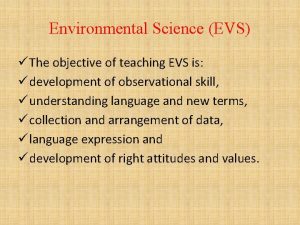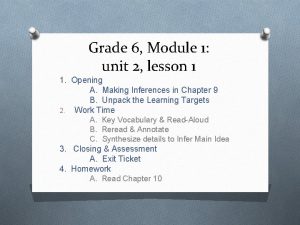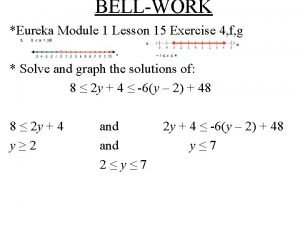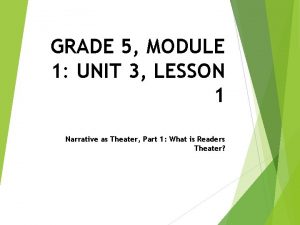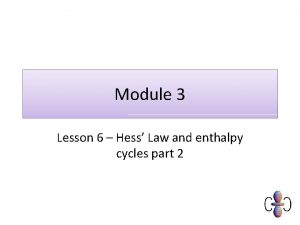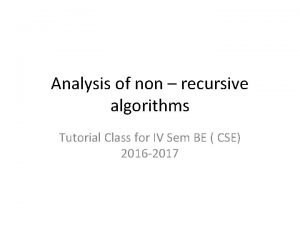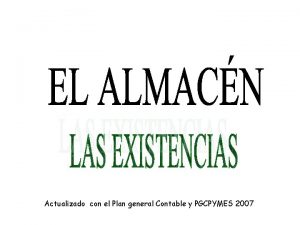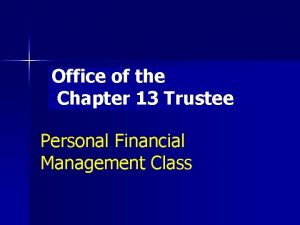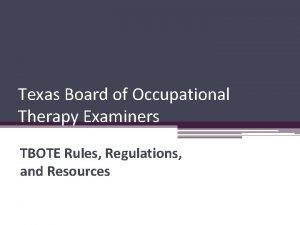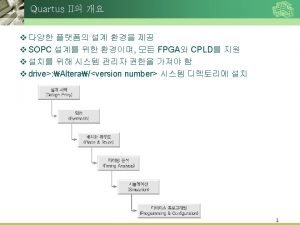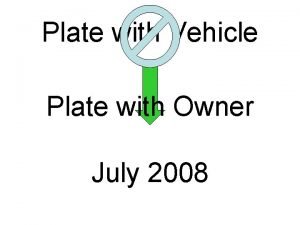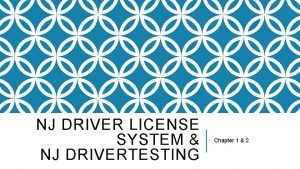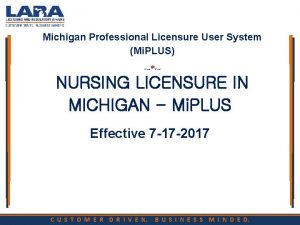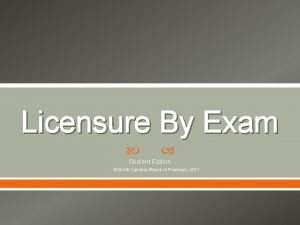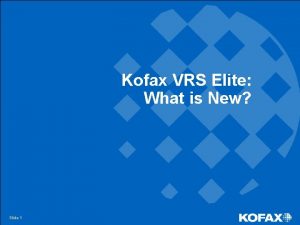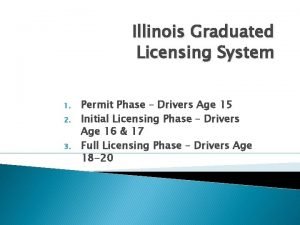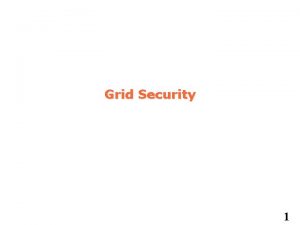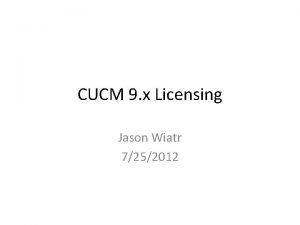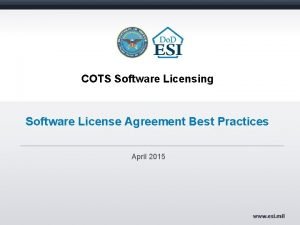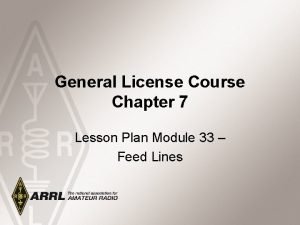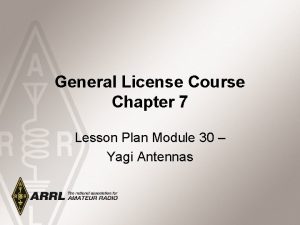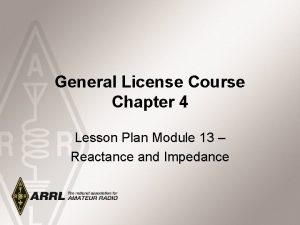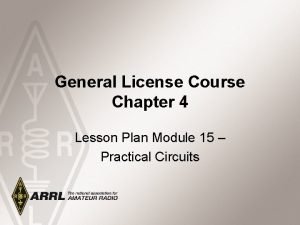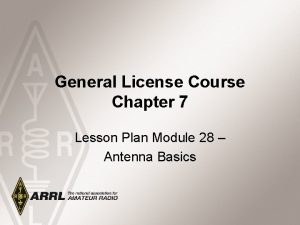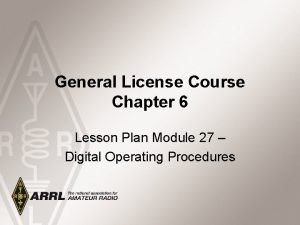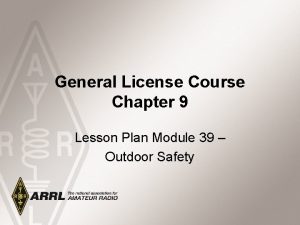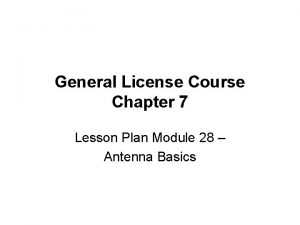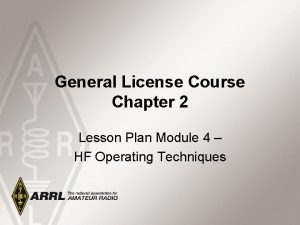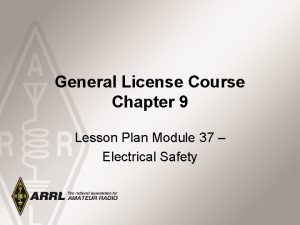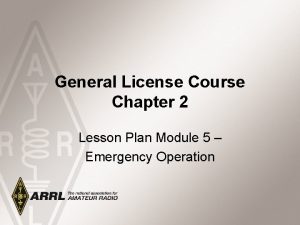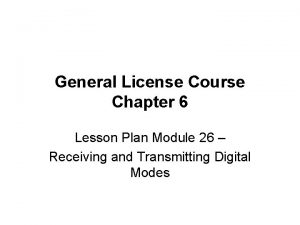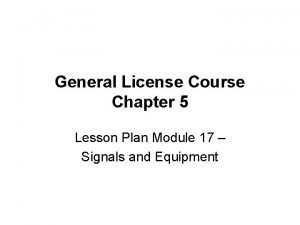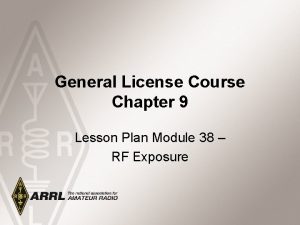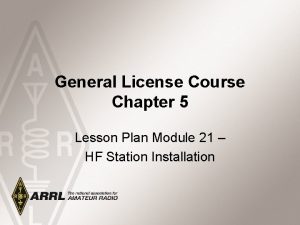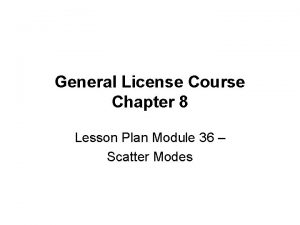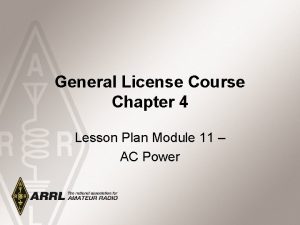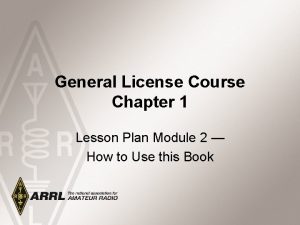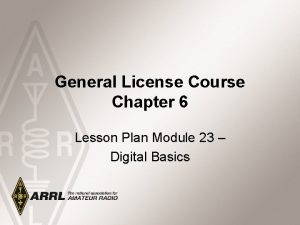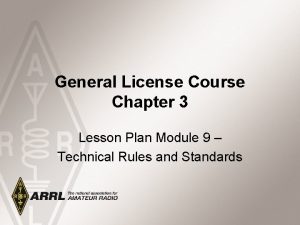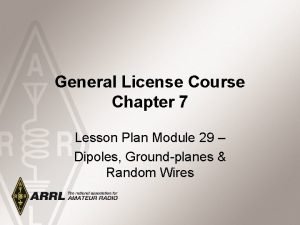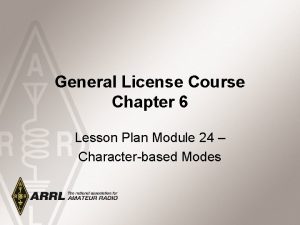General License Course Chapter 4 Lesson Plan Module










































































- Slides: 74

General License Course Chapter 4 Lesson Plan Module 14 – Active Components

Semiconductor Components • Diodes & Rectifiers • Junction diode uses PN junction to block flow of current in one direction • Current flows when a positive voltage is applied from the P-type to the N-type material (forward bias) • Diode forward voltage: silicon 0. 7 V, germanium 0. 3 V 2015 General License Course 2

Semiconductor Components • Diode Ratings: • Peak inverse voltage (PIV) – maximum reverse voltage before breakdown occurs. • Average forward current (IF) – Exceeding the diode’s rating will destroy the diode’s internal structure due to heat. • Junction capacitance (CJ) – when reverse biased, layers of P- and N-type material act like plates of a small capacitor. The larger the CJ the longer it takes to switch to conducting. 2015 General License Course 3

Diode Types • PIN diode – low forward voltage drop, used for RF switching • Schottky diode – low junction capacitance allows high-frequency operation • Varactor – reverse biased acts like a variable capacitor • Zener diode – used as a voltage regulator 2015 General License Course 4

Bipolar Transistors • Bipolar junction transistors have 3 electrodes: • Collector (C) • Base (B) • Emitter (E) • Controlled by current flow between base and emitter 2015 General License Course 5

Bipolar Transistors • Very little baseemitter current is required for the collector-emitter current to flow • Control of a larger current by a smaller current is current gain or beta ( ) 2015 General License Course 6

Field Effect Transistor (FET) • The FET has 3 electrodes • Drain (D) • Source (S) • Gate (G) • Controlled by voltage between gate and source. • Metal-oxide-semiconductors (MOSFETs) insulate the gate with a thin layer of oxide 2015 General License Course 7

Transistors • Transistors’ high amplification makes them useful as switches for voltage and current • Saturation – when further increases in input result in no output change • Cutoff – when the input signal reduces output current to zero • Saturation & cutoff states represent a digital ON/OFF switch • A transistor’s metal case can be connected to the chassis or heat sink by an insulator 2015 General License Course 8

Vacuum Tubes • All amplifying tubes have at least 3 electrodes • Compared to transistors, the tube is most like the field effect transistor (FET) • Vacuum tubes typically operate at hazardous voltages as high as 2000 to 3000 volts (use CAUTION!) 2015 General License Course 9

Vacuum Tubes Tube terminology: • Filament or heater – heats the cathode to make it emit electrons • Cathode – source of electrons • Control grid – regulates electron travel between the cathode and plate • Screen grid – reduces grid-to-plate capacitance • Suppressor grid – prevents electrons from traveling from the plate to the control or screen grid • Plate – collects electrons 2015 General License Course 10

Analog Integrated Circuits (ICs) • Analog ICs or “chips”: • Used for amplification, filtering, measurement, and power control • A linear voltage regulator is used to maintain a power supply output at a constant voltage over a wide range of currents • Operational amps (op amp) are used for dc and audio circuits 2015 General License Course 11

Digital Integrated Circuits (ICs) • Digital ICs operate with discrete values of voltage and current representing the binary numbers system values 0 and 1 • Digital electronic circuits operate with only two stable states of operation, ON or OFF • Digital circuits can perform computations or control functions • CMOS (complementary metal-oxide semiconductors) technology is popular because of its high speed and low power consumption 2015 General License Course 12

Digital Logic Basics 2015 General License Course 13

Digital Logic Basics • The basic building blocks of digital circuits are called gates • • Inversion (changing a 1 to a 0 and vice versa) OR and AND functions Inverted NOR and NAND Truth tables explain the Boolean functions implemented by the gates 2015 General License Course 14

Digital Logic Basics • Flip-flop – has 2 stable states • Sequential logic – built on flip-flops feeding other flip-flops (used in counters) • Example: a 3 -bit counter (one with 3 flip-flops) can count 23 = 8 different states • Example: a 4 -bit counter (one with 4 flip-flops) can count 24 = 16 different states • Shift register – a clocked array of circuits that passes data in steps along the array 2015 General License Course 15

RF Integrated Circuits • RF ICs are designed for functions commonly used for radio frequencies • Low-level high-gain amplifiers • Mixers • Modulators and demodulators • Filters • MMIC (monolithic microwave integrated circuit) works through microwave frequencies 2015 General License Course 16

Microprocessors & Components • A microprocessor is a computer on a single Integrated Circuit • Capable of performing billions of instructions per second using combinations of digital logic gates • Has parallel and serial input-output ports, counters and timers • Nearly all built from CMOS logic 2015 General License Course 17

Microprocessor Components • Memory: • Volatile memory loses the data stored when power is removed • Nonvolatile memory retains data permanently even when power is off • Random-access memory (RAM) can be read or written to in any order • Read-only memory (ROM) stores data permanently and can’t be changed 2015 General License Course 18

Microprocessor Components • Interfaces: • Serial interface transfers one bit of data in each transfer • Parallel interface transfers multiple bits of data in each operation • RS-232 serial interface is rapidly being replaced by USB (universal serial bus) serial interface • Modern computers don’t have RS-232 ports, so use the USB port and RS-232 converter to interface them to your transceiver 2015 General License Course 19

Microprocessor Components • Visual Interfaces: • Indicator – device that presents ON/OFF information (LED) • Display – device capable of presenting text or graphics in visual form • An LED is a special diode that produces light when it is forward biased • LEDs are available in several different colors, including white • LEDs have replaced incandescent light bulbs because they last longer and react faster 2015 General License Course 20

Microprocessor Components • Liquid crystal display (LCD) – created by sandwiching liquid crystal material between transparent glass panels • When voltage is applied to the electrodes on the front panel, the liquid crystals twist and block the light • LCDs require ambient or back lighting since the liquid crystal layer does not generate light 2015 General License Course 21

Practice Questions 2015 General License Course

What is the approximate junction threshold voltage of a germanium diode? A. 0. 1 volt B. 0. 3 volts C. 0. 7 volts D. 1. 0 volts G 6 A 03 2015 General License Course

What is the approximate junction threshold voltage of a germanium diode? A. 0. 1 volt B. 0. 3 volts C. 0. 7 volts D. 1. 0 volts G 6 A 03 2015 General License Course

What is the approximate junction threshold voltage of a conventional silicon diode? A. 0. 1 volt B. 0. 3 volts C. 0. 7 volts D. 1. 0 volts G 6 A 05 2015 General License Course

What is the approximate junction threshold voltage of a conventional silicon diode? A. 0. 1 volt B. 0. 3 volts C. 0. 7 volts D. 1. 0 volts G 6 A 05 2015 General License Course

Which of the following is an advantage of using a Schottky diode in an RF switching circuit rather than a standard silicon diode? A. Lower capacitance B. Lower inductance C. Longer switching times D. Higher breakdown voltage G 6 A 06 2015 General License Course

Which of the following is an advantage of using a Schottky diode in an RF switching circuit rather than a standard silicon diode? A. Lower capacitance B. Lower inductance C. Longer switching times D. Higher breakdown voltage G 6 A 06 2015 General License Course

What are the stable operating points for a bipolar transistor used as a switch in a logic circuit? A. Its saturation and cutoff regions B. Its active region (between the cutoff and saturation regions) C. Its peak and valley current points D. Its enhancement and depletion modes G 6 A 07 2015 General License Course

What are the stable operating points for a bipolar transistor used as a switch in a logic circuit? A. Its saturation and cutoff regions B. Its active region (between the cutoff and saturation regions) C. Its peak and valley current points D. Its enhancement and depletion modes G 6 A 07 2015 General License Course

Why must the cases of some large power transistors be insulated from ground? A. To increase the beta of the transistor B. To improve the power dissipation capability C. To reduce stray capacitance D. To avoid shorting the collector or drain voltage to ground G 6 A 08 2015 General License Course

Why must the cases of some large power transistors be insulated from ground? A. To increase the beta of the transistor B. To improve the power dissipation capability C. To reduce stray capacitance D. To avoid shorting the collector or drain voltage to ground G 6 A 08 2015 General License Course

Which of the following describes the construction of a MOSFET? A. The gate is formed by a back-biased junction B. The gate is separated from the channel with a thin insulating layer C. The source is separated from the drain by a thin insulating layer D. The source is formed by depositing metal on silicon G 6 A 09 2015 General License Course

Which of the following describes the construction of a MOSFET? A. The gate is formed by a back-biased junction B. The gate is separated from the channel with a thin insulating layer C. The source is separated from the drain by a thin insulating layer D. The source is formed by depositing metal on silicon G 6 A 09 2015 General License Course

Which element of a triode vacuum tube is used to regulate the flow of electrons between cathode and plate? A. Control grid B. Heater C. Screen Grid D. Trigger electrode G 6 A 10 2015 General License Course

Which element of a triode vacuum tube is used to regulate the flow of electrons between cathode and plate? A. Control grid B. Heater C. Screen Grid D. Trigger electrode G 6 A 10 2015 General License Course

Which of the following solid state devices is most like a vacuum tube in its general operating characteristics? A. A bipolar transistor B. A field effect transistor C. A tunnel diode D. A varistor G 6 A 11 2015 General License Course

Which of the following solid state devices is most like a vacuum tube in its general operating characteristics? A. A bipolar transistor B. A field effect transistor C. A tunnel diode D. A varistor G 6 A 11 2015 General License Course

What is the primary purpose of a screen grid in a vacuum tube? A. To reduce grid-to-plate capacitance B. To increase efficiency C. To increase the control grid resistance D. To decrease plate resistance G 6 A 12 2015 General License Course

What is the primary purpose of a screen grid in a vacuum tube? A. To reduce grid-to-plate capacitance B. To increase efficiency C. To increase the control grid resistance D. To decrease plate resistance G 6 A 12 2015 General License Course

Which of the following is an analog integrated circuit? A. NAND Gate B. Microprocessor C. Frequency Counter D. Linear voltage regulator G 6 B 01 2015 General License Course

Which of the following is an analog integrated circuit? A. NAND Gate B. Microprocessor C. Frequency Counter D. Linear voltage regulator G 6 B 01 2015 General License Course

What is meant by the term MMIC? A. Multi Megabyte Integrated Circuit B. Monolithic Microwave Integrated Circuit C. Military Manufactured Integrated Circuit D. Mode Modulated Integrated Circuit G 6 B 02 2015 General License Course

What is meant by the term MMIC? A. Multi Megabyte Integrated Circuit B. Monolithic Microwave Integrated Circuit C. Military Manufactured Integrated Circuit D. Mode Modulated Integrated Circuit G 6 B 02 2015 General License Course

Which of the following is an advantage of CMOS integrated circuits compared to TTL integrated circuits? A. Low power consumption B. High power handling capability C. Better suited for RF amplification D. Better suited for power supply regulation G 6 B 03 2015 General License Course

Which of the following is an advantage of CMOS integrated circuits compared to TTL integrated circuits? A. Low power consumption B. High power handling capability C. Better suited for RF amplification D. Better suited for power supply regulation G 6 B 03 2015 General License Course

What is meant by the term ROM? A. Resistor Operated Memory B. Read Only Memory C. Random Operational Memory D. Resistant to Overload Memory G 6 B 04 2015 General License Course

What is meant by the term ROM? A. Resistor Operated Memory B. Read Only Memory C. Random Operational Memory D. Resistant to Overload Memory G 6 B 04 2015 General License Course

What is meant when memory is characterized as non-volatile? A. It is resistant to radiation damage B. It is resistant to high temperatures C. The stored information is maintained even if power is removed D. The stored information cannot be changed once written G 6 B 05 2015 General License Course

What is meant when memory is characterized as non-volatile? A. It is resistant to radiation damage B. It is resistant to high temperatures C. The stored information is maintained even if power is removed D. The stored information cannot be changed once written G 6 B 05 2015 General License Course

What kind of device is an integrated circuit operational amplifier? A. Digital B. MMIC C. Programmable Logic D. Analog G 6 B 06 2015 General License Course

What kind of device is an integrated circuit operational amplifier? A. Digital B. MMIC C. Programmable Logic D. Analog G 6 B 06 2015 General License Course

Which of the following is an advantage of an LED indicator compared to an incandescent indicator? A. Lower power consumption B. Faster response time C. Longer life D. All of these choices are correct G 6 B 07 2015 General License Course

Which of the following is an advantage of an LED indicator compared to an incandescent indicator? A. Lower power consumption B. Faster response time C. Longer life D. All of these choices are correct G 6 B 07 2015 General License Course

How is an LED biased when emitting light? A. Beyond cutoff B. At the Zener voltage C. Reverse Biased D. Forward Biased G 6 B 08 2015 General License Course

How is an LED biased when emitting light? A. Beyond cutoff B. At the Zener voltage C. Reverse Biased D. Forward Biased G 6 B 08 2015 General License Course

Which of the following is a characteristic of a liquid crystal display? A. It requires ambient or back lighting B. It offers a wide dynamic range C. It has a wide viewing angle D. All of these choices are correct G 6 B 09 2015 General License Course

Which of the following is a characteristic of a liquid crystal display? A. It requires ambient or back lighting B. It offers a wide dynamic range C. It has a wide viewing angle D. All of these choices are correct G 6 B 09 2015 General License Course

What two devices in an Amateur Radio station might be connected using a USB interface? A. Computer and transceiver B. Microphone and transceiver C. Amplifier and antenna D. Power supply and amplifier G 6 B 10 2015 General License Course

What two devices in an Amateur Radio station might be connected using a USB interface? A. Computer and transceiver B. Microphone and transceiver C. Amplifier and antenna D. Power supply and amplifier G 6 B 10 2015 General License Course

What is a microprocessor? A. A low power analog signal processor used as a microwave detector B. A computer on a single integrated circuit C. A microwave detector, amplifier, and local oscillator on a single integrated circuit D. A low voltage amplifier used in a microwave transmitter modulator stage G 6 B 11 2015 General License Course

What is a microprocessor? A. A low power analog signal processor used as a microwave detector B. A computer on a single integrated circuit C. A microwave detector, amplifier, and local oscillator on a single integrated circuit D. A low voltage amplifier used in a microwave transmitter modulator stage G 6 B 11 2015 General License Course

Complex digital circuitry can often be replaced by what type of integrated circuit? A. Microcontroller B. Charge-coupled device C. Phase detector D. Window comparator G 7 B 01 2015 General License Course

Complex digital circuitry can often be replaced by what type of integrated circuit? A. Microcontroller B. Charge-coupled device C. Phase detector D. Window comparator G 7 B 01 2015 General License Course

Which of the following is an advantage of using the binary system when processing digital signals? A. Binary “ones” and “zeros” are easy to represent by an “on” or “off” state B. The binary number system is most accurate C. Binary numbers are more compatible with analog circuitry D. All of these choices are correct G 7 B 02 2015 General License Course

Which of the following is an advantage of using the binary system when processing digital signals? A. Binary “ones” and “zeros” are easy to represent by an “on” or “off” state B. The binary number system is most accurate C. Binary numbers are more compatible with analog circuitry D. All of these choices are correct G 7 B 02 2015 General License Course

Which of the following describes the function of a two input AND gate? A. Output is high when either or both inputs are low B. Output is high only when both inputs are high C. Output is low when either or both inputs are high D. Output is low only when both inputs are high G 7 B 03 2015 General License Course

Which of the following describes the function of a two input AND gate? A. Output is high when either or both inputs are low B. Output is high only when both inputs are high C. Output is low when either or both inputs are high D. Output is low only when both inputs are high G 7 B 03 2015 General License Course

Which of the following describes the function of a two input NOR gate? A. Output is high when either or both inputs are low B. Output is high only when both inputs are high C. Output is low when either or both inputs are high D. Output is low only when both inputs are high G 7 B 04 2015 General License Course

Which of the following describes the function of a two input NOR gate? A. Output is high when either or both inputs are low B. Output is high only when both inputs are high C. Output is low when either or both inputs are high D. Output is low only when both inputs are high G 7 B 04 2015 General License Course

How many states does a 3 -bit binary counter have? A. 3 B. 6 C. 8 D. 16 G 7 B 05 2015 General License Course

How many states does a 3 -bit binary counter have? A. 3 B. 6 C. 8 D. 16 G 7 B 05 2015 General License Course

What is a shift register? A. A clocked array of circuits that passes data in steps along the array B. An array of operational amplifiers used for tri-state arithmetic operations C. A digital mixer D. An analog mixer G 7 B 06 2015 General License Course

What is a shift register? A. A clocked array of circuits that passes data in steps along the array B. An array of operational amplifiers used for tri-state arithmetic operations C. A digital mixer D. An analog mixer G 7 B 06 2015 General License Course
 Micro lesson planning
Micro lesson planning Objective of evs
Objective of evs C device module module 1
C device module module 1 Supervisor development course module 2 answers
Supervisor development course module 2 answers Course module sample
Course module sample Class 7 english a gift of chappals lesson plan
Class 7 english a gift of chappals lesson plan Header bond t junction
Header bond t junction Course number and title
Course number and title Chaine parallèle muscle
Chaine parallèle muscle Ahrs army
Ahrs army Altering a driver's license
Altering a driver's license Chapter 1 nj driver license system
Chapter 1 nj driver license system Chapter 1 the new jersey driver license system answers
Chapter 1 the new jersey driver license system answers Chapter 1 lesson 1 your total health answer key
Chapter 1 lesson 1 your total health answer key Lesson 3 a new plan of government answer key
Lesson 3 a new plan of government answer key Planos en cinematografia
Planos en cinematografia Where did general lee surrender to general grant?
Where did general lee surrender to general grant? Hardship and suffering lesson 2
Hardship and suffering lesson 2 Module 5 lesson 5
Module 5 lesson 5 Unit 2 lesson 6
Unit 2 lesson 6 Practical/logistical issues in relationships
Practical/logistical issues in relationships Grade 6 module
Grade 6 module Module eleven lesson one self check quiz
Module eleven lesson one self check quiz Eureka math algebra 1 module 1 lesson 15
Eureka math algebra 1 module 1 lesson 15 Grade 5 module 1 lesson 1
Grade 5 module 1 lesson 1 Module 15 angles and segments in circles
Module 15 angles and segments in circles Module 3 lesson 6
Module 3 lesson 6 Course plan ppt
Course plan ppt Legales
Legales General arrangement of ship
General arrangement of ship Stowage plan tongkang
Stowage plan tongkang National general core value plan
National general core value plan Non recursive algorithm
Non recursive algorithm Define schlieffen plan
Define schlieffen plan Plan general contable actualizado
Plan general contable actualizado Course 2 chapter 1 ratios and proportional reasoning
Course 2 chapter 1 ratios and proportional reasoning Www.stevewyborney.com splat
Www.stevewyborney.com splat Chapter 13 personal financial management course
Chapter 13 personal financial management course Integers warm up
Integers warm up Lesson 2 the distributive property
Lesson 2 the distributive property Stevewyborney splat
Stevewyborney splat Work based learning license mn
Work based learning license mn Wisconsin ems license
Wisconsin ems license License smart register idtoken invalid input
License smart register idtoken invalid input The lightning thief teacher guide
The lightning thief teacher guide Coam master acct
Coam master acct Tbote license verification
Tbote license verification Microsoft spla reporting software
Microsoft spla reporting software Quartus ii web edition download
Quartus ii web edition download Raffle license michigan
Raffle license michigan South dakota temporary license plates
South dakota temporary license plates Osbn lpn scope of practice
Osbn lpn scope of practice Omma caregiver rules
Omma caregiver rules Nj 6 points of identification
Nj 6 points of identification Graduated drivers license nj
Graduated drivers license nj Sap licensing negotiation
Sap licensing negotiation Nc license and theft bureau
Nc license and theft bureau Miplus nursing
Miplus nursing Naplex score transfer
Naplex score transfer California medical license for foreign medical graduates
California medical license for foreign medical graduates Kofax vrs basic
Kofax vrs basic Kentucky board of nursing renewal
Kentucky board of nursing renewal Taxi license finland
Taxi license finland Sas license cost
Sas license cost Illinois graduated drivers license
Illinois graduated drivers license Hid mobile access license
Hid mobile access license Pesticide warning signs ontario
Pesticide warning signs ontario Emd license
Emd license Dell rok license
Dell rok license John doe drivers license
John doe drivers license Dcas dubai
Dcas dubai Dmc trade license online
Dmc trade license online Cucm enhanced license
Cucm enhanced license Software licensing best practices
Software licensing best practices Bc gaming account summary report
Bc gaming account summary report

